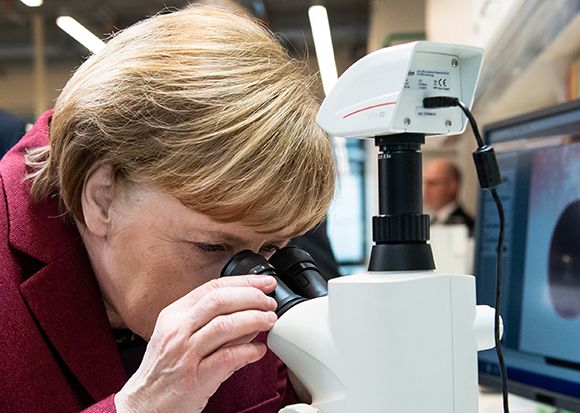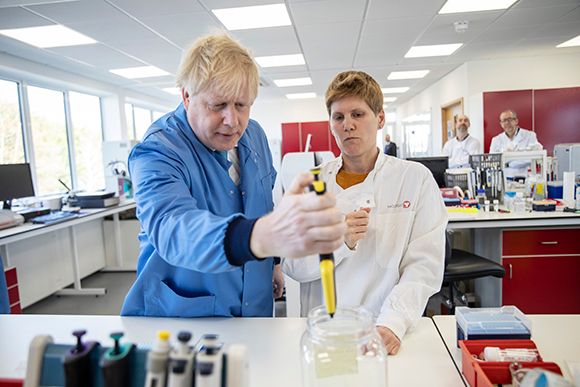When I reached Dr Rainer Schwertz, in Heidelberg, he expressed something that has been in short supply from nearly everyone in the UK: honest hope that the Covid-19 crisis may be under control. “For four weeks here we have had more recoveries from Covid-19 than new cases,” he told me. Schwertz is head of the public health department in the Rhein-Neckar district of Germany, a local administrative region of over 600,000 people, which includes the city of Heidelberg. Germany has been lauded for its response to the coronavirus crisis, moving quickly with an aggressive track-and-trace strategy that appears to have stalled the outbreak and prevented it from overwhelming the health system—as I write, Germany’s death rate, adjusted for population, is less than a quarter that of the UK.
The response that Schwertz and his deputy, Dr Andreas Welker, outlined to me is surely a big reason why. For them, the crisis began in earnest on 27th February, the moment the first confirmed case was reported in a local hospital—a person who had just returned from a skiing holiday in Italy. “We realised people are coming back from Carnival vacation, and there would be more cases,” said Welker. “The numbers were not bad yet, even to the first week of March, but we saw what was happening in China, in Europe, and we took a leap of faith to scale up,” added Schwertz.
Starting the next day, the public health authority restructured all its departments towards crisis response—staff that usually worked on dentistry or children’s health were moved to public information call centres or processing testing data. “At first we asked the University of Heidelberg for some medical students to help out—initially there were 11, a week later there were 120,” said Schwertz. The local government seconded 100 staff to public health and opened the coffers for “whatever we needed,” he explained. And indeed, Stefan Dallinger, the district administrator of the Rhein-Neckar region told me: “In the beginning I didn’t know what an FFP2 mask was, but the doctors know best and my job is to back them up, give them the budget to do everything.”

From the beginning, the plan was clear. Widespread testing had been recommended by the Robert Koch Institute, the national body in charge of infectious disease response, and the state government was recommending the same. The strategy was to test anyone who had symptoms, and track down all the people they had contact with to isolate them as well, snuffing out potential spreaders and keeping pressure off the hospitals and ICU bays. The University Hospital laboratories switched their research personnel and equipment to coronavirus testing. The call centre that the health authority set up fielded 2,000 calls a day, directing residents to hospital testing centres and then, when they began to worry about spreading within the hospital, to three remote testing stations set up a few weeks later.
The ability to test made the outbreak visible and allowed precise responses. The doctors began a “corona-taxi” service—medics in local authority cars checking up on asymptomatic people who had shown up as infected at home, keeping them away from hospital. They built a separate facility to house Covid-19-positive care home residents, shielding other residents from them, while also keeping them out of ICU until necessary. None of this could have been done without widespread testing of suspected cases.
Things weren’t perfect. “The labs we used couldn’t always get the reagents. We never knew if one week later we would have to stop testing,” said Welker. But disaster never struck. Schwertz and Welker said they were lucky. Unless you take the view that Germany has made its own luck, it must have been allotted quite a bit of it. Although states and regions have significant autonomy to direct their own response, it has been uniformly good across the country, even if not quite as good as Rhein-Necker. As of 27th April, the district had only 35 coronavirus deaths, about 10 deaths fewer than would be expected given Germany’s national average rate. By comparison, the same population mapped onto the UK could expect over 200 deaths.
Germany and the UK logged their first coronavirus cases within two days of each other—27th January in Bavaria and 29th January in York—but since then have taken different paths. We have all become obsessive graph watchers, and over the past eight weeks, while Germany has been a strong performer on virtually all the metrics, we have lagged behind—fewer tests, fewer hospital beds, tardier treatments—as we rapidly climb the most watched and indisputably telling measure of all, total deaths. It has become common knowledge that they have succeeded, even as we struggle to admit we have failed. When a Department of Health source told the Sunday Times: “We could have been Germany,” the message was all too clear.
And Britain only needed to open its ears to know that testing would make all the difference. In the week of 16th March, when WHO Director General Tedros Adhanom Ghebreyesus admonished nations to “test, test, test,” the Koch Institute—Germany’s government agency directing the coronavirus response—reported that more than 170 labs across the country were already doing a combined total of over 15,000 tests a day and that 400,000 had been completed since February. The UK at that time had not even reached a cumulative 40,000. By the end of that month, when Matt Hancock tweeted the UK had finally reached 10,000 tests a day, German media were reporting that a single lab in Cologne, DR Wisplinghoff, was on its own managing 5,000 tests every 24 hours.
Theories abound as to what might have made this difference. The more decentralised German health system, with more market competition and private laboratories? The greater institutional strength of German political leadership? Their biotech and mighty chemical industries underwriting their regime while ours were struggling to buy lab supplies? Or even their national character—competent, meticulous, upbeat—being somehow better suited to the crisis? None of this is quite right. Their success is complex in its details, but simple in precis: at every level they were co-ordinated, flexible and prepared. They knew what their healthcare system could do, and they worked within it. Our leaders, by contrast, sometimes appear to be describing the powers of a system that doesn’t exist.
“Germany’s success is complex in its details, but simple in precis—it was co-ordinated, flexible and prepared”
One particular advantage was clear: if you want to test a lot of people for coronavirus, it helps to invent the test first. A team at Berlin’s Charité Hospital developed a test for Sars-CoV-2 in mid-January. It shouldn’t have taken that long for others to catch up—the protocol was, after all, made publicly available by the WHO on 17th January. But despite the German test being available, the British government opted for some reason to develop its own in-house test, which came into use more than three weeks later on 10th February. A British medical virologist who didn’t want to be named told me they didn’t believe an in-house test was necessary. This tendency to turn inwards, away from obvious solutions, would come to characterise the British response.
The wisdom of rapid testing isn’t arcane or complicated. “The larger the number of undetected infected people, the faster the spread,” Koch Institute head Lothar Wieler explained at a late March press conference. If you can identify who has the virus, you can isolate them, and then move on to test everyone they may have infected as well. Do this fast enough and you break the exponential spread of infection. The WHO calls “test and trace” the “backbone” of Covid-19 response.
And yet despite this, the UK government admitted to abandoning this standard strategy sometime in mid-March. Yvonne Doyle, medical director of Public Health England (PHE), told the House of Commons Health and Social Care committee on 26th March that test and trace had recently been stopped. The same week, Deputy Chief Medical Officer Jenny Harries told reporters testing and tracing in the general population was not an “appropriate intervention” at the time, and suggested that the WHO’s advice was only for “low- and middle-income countries.” The government has since scrambled to scale up testing, and Hancock announced in late April that large-scale contact tracing would
be resumed.
The structural differences between the German and British government and health systems are immense, and in some respects the early lead Germany jumped out to in testing appeared to be a product of these differences. Responsibility is highly devolved—below central government there is a strong state government, and below that more than 400 districts with public health responsibilities that can extend to running hospitals. Each level is granted a high degree of autonomy, leading to rapid, ad-hoc solutions like those seen in Rhein-Neckar. “Because we’re so decentralised people look for solutions in their own area. They don’t depend on direct orders,” explains Dr Peter Tinnemann, a public health researcher at Charité Berlin.
Anyone that wanted to scale up testing early was allowed to go to private labs—approved by the Koch Institute—or cobble together their own solutions. “We saw what was coming and made the decision regionally. Everybody had a PCR machine [required for testing] in the basement, we put those into service. Our transfusion service had a machine and we got it working round the clock,” said Matthias Orth, head of laboratory medicine at Marienhospital Stuttgart and a board member of the German Association of Clinical Pathology, whose own hospital began expanding testing in late February.

The situation in the UK, where power is concentrated and often hoarded in central bodies, couldn’t have been more different. PHE centralised testing in eight labs that it controlled, with an initial capacity of 1,000 tests per day. This eventually expanded to hospital labs, but I spoke to doctors at several London hospitals and none of their in-house labs started testing until mid-March, three weeks after many German regions. Before that they were sending tests away to PHE, which became a bottleneck in the system.
I also spoke with several medical researchers in charge of labs with the expertise, equipment, and health and safety clearance to provide testing, who contacted PHE to offer their services in March, but were either ignored or rebuffed. “A good lab could do 1,000-2,000 tests a day. We could easily have 50 of those labs doing 50,000-100,000 tests a day. We were offering the facilities but it wasn’t on the cards at the time,” explained Alan McNally, of the University of Birmingham’s Institute of Microbiology and Infection.
But a decentralised health service isn’t the only answer: in the wrong circumstances, it would be no answer at all. Hundreds of autonomous actors could lead to chaos instead of coordination. While many of the local officials and doctors I spoke to were confident about acting independently, Maike Voss, a public health researcher at the German Institute for International and Security Affairs, which advises parliament, said she spoke with local authorities who were “helpless in the beginning,” and looked to the central government for support. Advice and support are important.
The Koch Institute provides guidance for all levels of government below it, which isn’t enforceable, but is traditionally followed. “It would be very difficult not to follow the guidance, you’d need a very good explanation,” said Tinnemann. “Some local regions realised very early. But when the federal level started taking it seriously it filtered down quickly. Everyone got into gear.” Jens Spahn, health minister, pushed to declare the outbreak a pandemic on 4th March, more than a week before the WHO.
“British ministers and advisers have delayed and equivocated explaining their strategy, leaving workers to guess at what it may be”
And the central government has stepped in when the local authorities have been unable to cope, for example sourcing the chemical reagents needed for testing. “Everyone was doing their own procurement but many were overwhelmed. The local government often stepped in to buy in bulk. It then moved towards the national level,” said Voss. A representative for the state of North Rhine-Westphalia says the state Health Ministry has directly negotiated bulk purchases of over 1.1m test kits which it has distributed in the region.
This is a level of co-ordination that the UK’s political establishment and civil service has been totally unable to match—and this isn’t just about structures, but decisions. The UK’s health service is more centralised, and yet on 25th March Sharon Peacock, PHE’s National Infection Service Interim Director, told the House of Commons Science and Technology committee inquiry that it had considered allowing more distributed testing early in the crisis, following the South Korean example, and rejected it. This is despite PHE recently disbanding its own network of regional labs intended to support the NHS during an infectious disease emergency.
The UK government holds immense power to direct health policy, and yet from Boris Johnson down, ministers and senior scientific and medical advisers have delayed and equivocated explaining their strategy, sometimes leaving workers to guess at what it may be.
The countries that have addressed the crisis well don’t share many structural similarities. Germany is not much like South Korea, and neither are like Singapore. What they all did was manage to marshal energy towards the maxim of “test and trace.” Their reward was precious life for their citizens. In the UK, our civil service has been at time hubristic, convinced the centre could hold its grip on a system cut back to breaking point, our politicians have been clueless, a step late or a step off-course. The penalty, for citizens, is nearly too terrible to imagine. For those of us glued to the charts, it is etched above the grim British curves that could soon resemble the horror of the United States.












